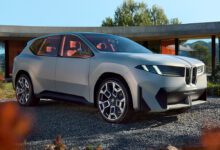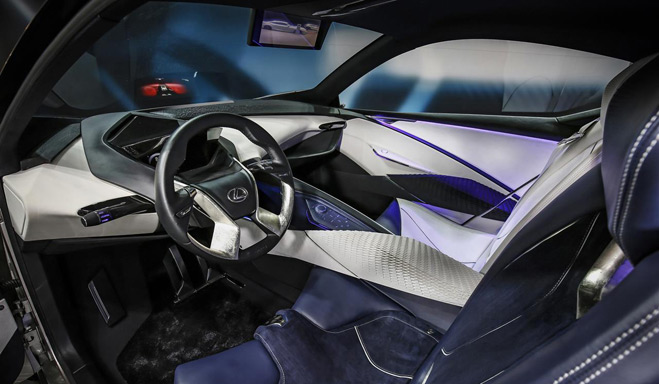
These concepts show how Lexus sees the future
Futuristic concept cars rarely go into production. However, they perfectly represent how car manufacturers and their designers see the future. And some of the solutions used in them also end up in production cars over time. Lexus is keen to get closer to such projects. We present four concepts of the Japanese brand in recent years, which set the direction for the development of Lexus cars.
Lexus LF-30 Electrified - the car of the future
The LF-30 Electrified is the latest creation from the Lexus engineers. The car was created in 2019, just in time for the 30th anniversary of the Japanese brand. Thus, the number in its name is not accidental, as is the element Electrified, which denotes a new line of electrified Lexus models. The concept is powered by four compact electric motors located in the wheel hubs, and the vehicle itself heralds the revolution that Lexus is planning in the world of electric vehicles.
Lexus LF-30 Electrified
This arrangement of power units provides real advantages - the car does not have differentials and driveshafts, and this allows engineers to find more space inside the car. The use of independently operating motors has also revolutionized the way cars are driven. It allows you to individually adjust the driving force going to each of the wheels, as well as front, rear or all-wheel drive, depending on the needs. Another interesting feature is the electronically controlled steering system, ie. without mechanical connection between steering wheel and wheels. Thanks to this, the steering wheel can be pulled out in the hands of the driver or retracted after the autonomous driving mode is activated.
The interior of the Lexus LF-30 Electrified features a host of new technologies - the driver has an improved HUD display, and on-board systems are controlled using gestures, touch and speech. The glass roof over the rear seats is a gesture- and voice-controlled display that uses augmented reality technology to present a variety of information, images (such as a view of the starry sky), video and navigation directions. The rear seats use artificial musculature technology to match the anatomy of the passengers. Built-in speakers in the headrests not only harmonize with the audio system, but also guarantee complete noise reduction and absolute silence if desired. And the side windows have adjustable light transmission for increased privacy.
Lexus LF-30 Electrified
The list of technological innovations is even longer. On-board artificial intelligence distinguishes the voices of passengers and uses personalized information stored in the driver's key. Thus, it can automatically set the temperature, the operation of the audio system, or suggest destinations for navigation. It also understands rider preferences and assists with real-time suspension and transmission settings. The Lexus Airporter drone also works with the LF-30 Electrified. A drone controlled by an autonomous system can perform tasks such as transporting luggage from the doorstep of a house to the trunk of a car. The concept car is also equipped with autonomous parking and pickup features. So the LF-30 Electrified can drive autonomously from a parking space to your front door. The Lexus Electric Concept also benefits from wireless inductive charging. And the AI-driven energy flow management system optimizes the flow of electricity in the home, distributing it between the home and the car according to the user's daily schedule.
Lexus LF-30 Electrified
The latest Lexus concept certainly stands out for its unique look. Thanks to the electric drive, the car was removed from the hood, so the characteristic hourglass motif covered the entire body of the car. In addition, the color of the car's front bumper and the pattern of the luminescent elements make it possible to see from the outside whether the car is being used normally or autonomously. Despite its futuristic nature, the LF-30 Electrified contains the traditional Japanese finish Yakisugi, an anaerobic-fired cedar wood. They were used to create floor inlays and steering wheel trim. And the metal, recycled and recycled into fine fibers, supports the folds of the door upholstery. The concept car is intended to set the direction in which Lexus Electrified cars will develop until 2030.
Lexus LF-1 Limitless - updated flagship SUV
The LF-1 Limitless, introduced by Lexus at the beginning of 2018, impresses, first of all, with its unusual appearance. It is a muscular luxury SUV, over five meters long, whose appearance is more reminiscent of a grand tourer. This is due to the long hood, low roofline and 22-inch wheels. As well as a stylistic concept called Lexus designers Molten Katana (Molten Samurai Sword). In keeping with this philosophy, the copper-gold body design combines liquid metal shapes with the sharp edges of a traditional Japanese sword.
Lexus LF-1 Limitless
Beneath the elegant exterior lies an equally thoughtful interior with a minimalist yet luxurious character. They were stripped of the analog knobs and buttons, which were replaced with motion- and touch-sensitive elements. The navigation and entertainment system is controlled by touch panels with haptic feedback mounted on the front and rear of the concept car. One of them even has a handwriting recognition system. Rear passengers have the same seats as the front ones, with more legroom and separate screens to control the air conditioning and entertainment system.
The interior design uses finishing elements in shades close to the colors used outside, but with a warmer satin finish. Additional metallic accents contrast with cocoa-coloured leather trim and perforated leather seat upholstery. Lighting plays an important role in creating the mood of an interior. Pressing the "Start" button activates the background lighting, the configuration of which depends on the selected driving mode. An additional effect is given by additional miniature LED lights hidden behind perforated wooden door panels.
Lexus LF-1 Limitless
The Lexus LF-1 Limitless features a navigation system that expands on traditional time-based solutions. It acts as an additional assistant, anticipating the needs of the driver and passengers based on the distance traveled, traffic and road conditions on the programmed route. Based on this, the system suggests refueling, rest and lunch breaks, and even offers to book a hotel room. Navigation information is displayed on the dashboard monitor and rear screens of the multimedia system. What's more, they can also be transmitted wirelessly to passengers' smartphones or tablets.
Lexus LF-1 Limitless
The driving comfort of the LF-1 Limitless is also enhanced by advanced driver assistance solutions. Chauffeur Mode allows you to steer your vehicle without driver intervention, in which the system controls the steering wheel, brakes, acceleration, lights, and signals. For more active driving, the drive controls and main sensors are located on the steering wheel, allowing the driver to better concentrate on the road. An interesting fact is also two additional displays on both sides of the clock, which displays the image from the cameras that replace the side mirrors. Lexus engineers say the LF-1 Limitless concept is designed with a variety of powertrains in mind – be it hydrogen, hybrid, plug-in hybrid, combustion engine or electric. According to numerous rumors, Lexus intends to fight more actively in the sport utility vehicle market. The LF-1 Limitless could be a good base for such a car.
Lexus LF-FC hydrogen road cruiser
The unique, elegant design is also the strength of another Japanese manufacturer's concept, the 2015 Lexus LF-FC. It is a sedan with a length of 5.3 m and a width of 2 m with a sporty character, which is emphasized above all by the gently sloping roofline. The effect is enhanced by sporty 21-inch carbon fiber alloy wheels.
Lexus LF-FC
Lexus designers divided the interior of the LF-FC into two parts - upper and lower. The upper should give a feeling of openness, allowing the driver to focus on the road, because the driver has a highly functional cockpit, and the front seats seem to float in the air. The rear seats are for those who like to be passengers. The seats even recline to a reclining position, and there's plenty of head and knee room around them. Aniline leather on the seats, doors and dashboard adds a luxurious feel.
The Lexus Concept Sedan's systems can be controlled with simple gestures without touching the control panel. A holographic image on the center console shows how the system interprets user input and controls the audio system and ventilation. The Lexus LF-FC is also equipped with automated technologies to support the driver and improve safety. As promised by Lexus, the LF-FC is part of the vision for a world without accidents.
Lexus LF-FC
However, the most important feature of the concept is the drive source. The heart of the futuristic limousine is a powerful hydrogen fuel cell system that powers all wheels. The system drives the rear axle and also sends power to two electric motors at the front. The innovative Lexus LF-FC drive system allows precise control of the distribution of torque between the front and rear wheels, which improves the dynamics and stability of the car on the road. The location of the transmission is also of great importance. The fuel cells are at the rear of the car, the power control unit is at the front, and the hydrogen tank is T-shaped for optimal weight distribution.
Lexus LF-FC
Lexus plans to bring a hydrogen fuel cell vehicle to market. Thus, the LF-FC is a perfect example of what such a car could look like in the future.
Lexus LF-SA - the future in the city
Luxurious SUVs and powerful limousines are nothing new for Lexus. But when creating the LF-SA concept, the designers of the Japanese brand went in an almost unknown direction. The Lexus LF-SA is the epitome of a luxurious city kid. The unusual concept measures less than 3.5m long and 1.7m wide and can accommodate up to four people. The car was presented at the Geneva Motor Show in 2015.
Lexus LF-SA
This design, which is unusual for Lexus, nevertheless has an appearance characteristic of the Japanese brand. There are also deep sculpted body lines, a powerful hourglass-shaped grille or sharply drawn headlights. The urban Lexus LF-SA also boasts a coupe-like silhouette, powerful wheels and strongly accentuated muscular rear wheel arches. What's more, the show car was painted silver to represent space exploration. Therefore, a comparison with a small spacecraft is acceptable.
Inside the Lexus concept are four seats with a rather unusual layout. The driver's seat is stationary, while the position of the steering wheel and pedals can be adjusted. Access to the rear seats is possible thanks to the sliding front passenger seat. Thus, the designers emphasized the priority of the driver's seat. This character was further enhanced by the stylistic design of the cabin, which symbolically divides the space into two zones - driver's and passenger's. Instead of a clock, we can also find a digital display stylized as a holographic screen. And the traditional center console has been replaced by a wide-angle head-up display at the center of the base of the windshield.
Lexus LF-SA
So far, Lexus has not presented any specific plans to launch a small city car into production. But the LF-SA could be an interesting base for a small personal electric vehicle. And as you know, the Japanese brand has been investing heavily in electric vehicles lately.
Photo: Lexus















